XC40 is new, stylish, agile — and still Volvo-safe
AUSTIN, Tx.
With snow up to our knees in Duluth, Minnesota, after a mid-February blizzard, I had two choices. I could (A) keep reviewing a half-dozen different SUVs, trucks, and AWD sedans that I have been driving to handle the snow and ice, or (B) I could escape to Austin, Texas, for the introductory media drive of the all-new Volvo XC40.
I chose “B.”
It was not just to avoid the latest mid-February storm, because to go, I had to miss some really good sectional high school hockey playoff games. However, I have been waiting for about three years for Volvo to create the XC40 and to get my hands on one, and seeing it on display at the Detroit and Chicago Auto Shows, I couldn’t resist.
Regular readers of my automotive reviews, in the Duluth Reader, or on the Newcarpicks.com website, know that my preference in SUVs is to go for the smallest one that’s big enough. Anything larger is wasted weight to haul around. Volvo has an exceptional XC90 SUV, which won Truck of the Year and outperforms larger SUVs. Volvo also has the XC60, which is a more compact midsize SUV with the same drivetrain — a sophisticated 2.0-liter 4-cylinder engine either turbocharged or both supercharged and turbocharged for amazing power, while still delivering impressive fuel economy. Both also feature Volvo’s long-standing tradition of building the safest vehicles on the road.
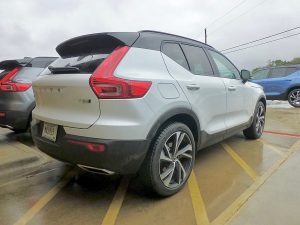
Fresh design varies from Volvo tradition, inside and out, pushing the XC40 to the forefront of contemporary style.
The XC40 comes along considerably more compact, and it shares in all those assets including the balanced handling and the vault-like safety structure, and the turbo 4, but it’s far from simply another downsizing exercise.
“Usually a new vehicle is based on an existing one,” said Anders Gunnarson, Volvo’s senior design manager. “But the XC40 started fresh. It is a cousin of the XC90 andXC60, but we wanted to give it its own identity. You can see the similarities, but also the differences. The XC40 is based on our new CMA — Compact Modular Architecture.
“Our objective was to give it three main things — expressive design, smart technology, and ingenious storage. It has true SUV proportions, with short, compact overhangs front and rear. As designers, we get inspired by things other than cars, and we chose the materials and colors for the interior carefully.
We drove the “Momentum” and the “R Design” models around downtown Austin, then out west of the city into the famous Texas Hill Country, where challenging winding roads become more challenging because Texans apparently don’t think enough of shoulders to put them on the outside of their 2-lanes. Volvo also makes an upscale “Inscription” model.
All of the XC40s can be bought with all-wheel drive, a $2,000 option on the front-wheel-drive base versions. All of the initial test cars had that impressive feature, which helps it snake around corners, and, presumably, would be an enormous benefit to those trying to scale the cliffs of Duluth in the snowstorms I left behind.
The powertrain is another example of Volvo engineering, with a 4-cylinder engine measuring just under 2.0 liters (1.969 cubic centimeters, actually). The now-familiar aluminum Volvo 4 has direct injection and is boosted by a turbocharger in the XC40, and its power ratings are impressive: 248 horsepower at 5,500 RPMs, and 258 foot-pounds of torque with that peak ranging from 1,800-4,800 RPMs. Miraculous, what these engineers can do with a strong design, turbocharging, direct injection, and computers coordinating it all.
An 8-speed automatic transmission is standard, and it does a very good job in the Momentum, which starts at $35,200 with all-wheel drive, although you simply put the gear lever into “D” for drive and let it go. In the sportier R Design, we had a separate sport-manual gate we could shift into for manual operation, plus it had steering wheel paddles, which convert the power and transmission from impressive SUV category to sport-sedan-like pep and fun.
The Momentum had 19-inch wheels, although 18-inch are the standard size on the base front-wheel-drive XC40. The R-Design my co-driver and I drove had 20-inch alloys. Designers love 20-inch wheels, because they like to draw their designs with large wheel openings, then they feel compelled to fill those openings with larger wheels than anyone needs.
Without a doubt, larger wheels — which have thinner tire sidewalls to duplicate the smaller wheels with thicker sidewalls — make your vehicle corner shaper and have more sporty precision around curvy roads. However, they also offer less cushioning from the narrower sidewalls, and can translate into harsh feeling on rough roadways.
I thought both XC40s we drove handled very well. MacPherson struts in front and a 4-link rear suspension with stabilizer bar kept us on the road no matter how we challenged it. And while we didn’t have anything resembling snow, we had steady rain threatening to turn into thunderstorms in, I hesitate to say, 72-degree temperature.
Naturally, the engineering technology came from the XC90 by way of the XC60, but one thing that prevents the lighter, more agile, and sportier looking XC40 in the mid-$30,000-and-up range is that Volvo officials have deduced that while customers want SUVs, and have made the compact-crossover SUV segment the fastest growing in the industry, customers also want all the creature comforts they can find in the larger SUVs.
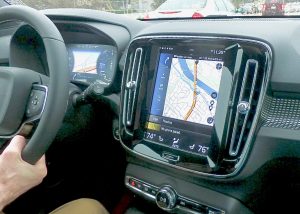
Enlarged navigation screen, clever stowage niches for computers and connectivity dominate the interior
Added to all those lane-departure and alerts to help you avoid accidents and physical intrusion if you still seem headed for one, the XC40 adds some specific interior tricks. Storage cubicles seem to be everywhere, and you could fit an iPad or a small laptop in form-fitted slots in the doors, and in storage drawers under the front bucket seats. There also is a build-in charge pad at the front of the console for your cellular phone.
Open the hatch and there is a roomy storage area, and it also has ingenius features such as a rear floor that folds up to offer security for grocery bags, and there are special hooks designed to hold more bags in isolation. A hidden compartment under the rear floor panel also is standard.
Standard equipment includes LED lights, digital gauges, leather seats, lane departure warning, and off-road mitigation, which actually will do its best to prevent you from drifting off the highway.
Those bucket seats, by the way, continue Volvo’s tradition of making simply the best, most comfortable, and most supportive seats in the industry. These are smaller and lighter, but just as comfortable.
Optional also is a Harmon Kardon audio upgrade which has 13 speakers and enough power to light Austin and parts of Dallas. Sitting in the rear seat, the separation and clarity of this audio system is exceptional.
After proving to myself that the XC40 lived up to the lofty standards I had set for it, all I could envision was the chance to get one for a week’s test drive in the Great White North of Minnesota. Preferably while there’s still snow to be churned through.


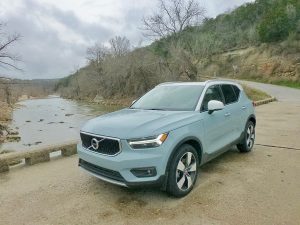
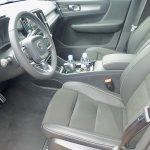
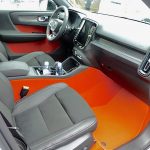
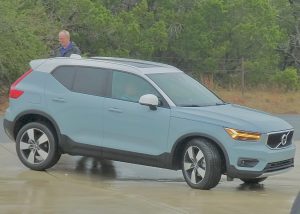
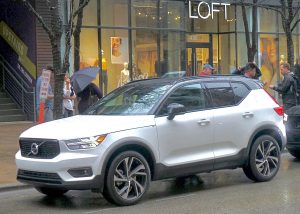
 John Gilbert is a lifetime Minnesotan and career journalist, specializing in cars and sports during and since spending 30 years at the Minneapolis Tribune, now the Star Tribune. More recently, he has continued translating the high-tech world of autos and sharing his passionate insights as a freelance writer/photographer/broadcaster. A member of the prestigious North American Car and Truck of the Year jury since 1993. John can be heard Monday-Friday from 9-11am on 610 KDAL(www.kdal610.com) on the "John Gilbert Show," and writes a column in the Duluth Reader.
John Gilbert is a lifetime Minnesotan and career journalist, specializing in cars and sports during and since spending 30 years at the Minneapolis Tribune, now the Star Tribune. More recently, he has continued translating the high-tech world of autos and sharing his passionate insights as a freelance writer/photographer/broadcaster. A member of the prestigious North American Car and Truck of the Year jury since 1993. John can be heard Monday-Friday from 9-11am on 610 KDAL(www.kdal610.com) on the "John Gilbert Show," and writes a column in the Duluth Reader.